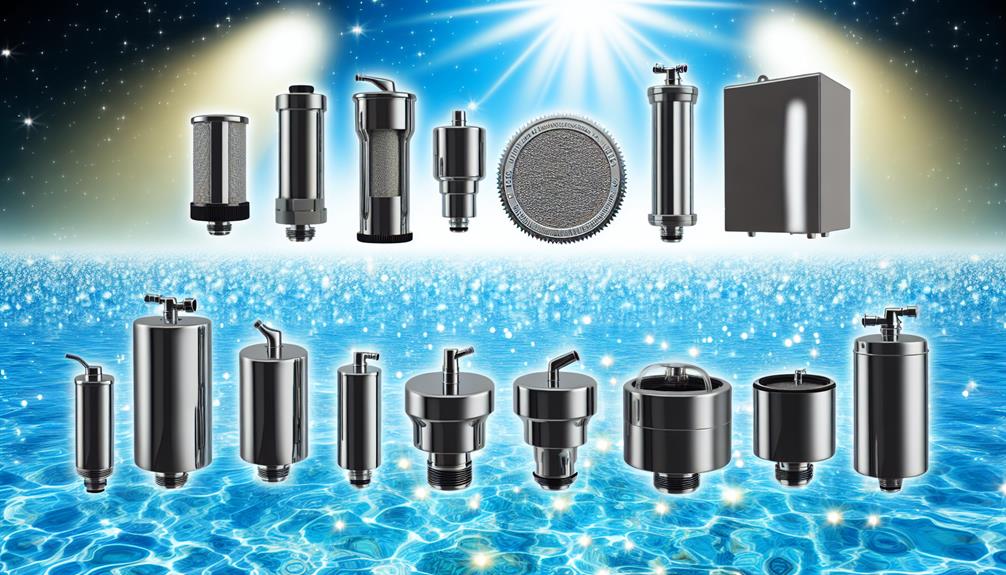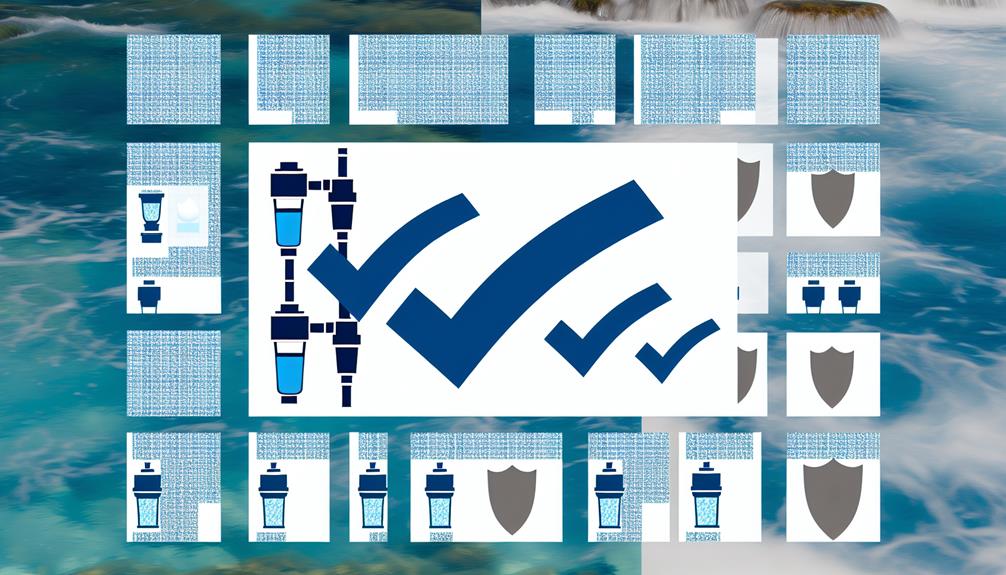Have you ever considered how crucial water filtration is to the safety and compliance of your industrial operations?
As you navigate the complexities of maintaining water purity, it's essential to understand that the effectiveness of your industrial water filters isn't just about performance; it's also about adherence to stringent safety standards.
You need to stay informed about the key tips that can safeguard your systems against violations and potential hazards. Whether you're conducting hazard analysis, implementing filtration controls, or ensuring your staff are adequately trained, each step is a critical component in the safety compliance puzzle.
As you continue, you'll uncover the significance of regular maintenance procedures, thorough documentation, and the unyielding vigilance required to keep your water filtration system in check—elements that could mean the difference between flawless operation and costly oversight.
Understanding Regulatory Standards
To ensure industrial water filters meet safety compliance, it's crucial to recognize and adhere to the local, national, and international regulatory standards governing food safety. You must stay fully informed about the regulatory landscape, which includes understanding the permissible contaminant levels and the required monitoring frequency to maintain quality. Compliance with regulatory standards isn't just about ticking boxes; it's about ensuring the safety and quality of the water used throughout industrial processes.
You're tasked with implementing water quality monitoring systems that are robust and accurate. This means selecting data analysis software that can interpret collected information precisely. Your choice of water purification technologies should be informed by the specific contaminant types, volume flow rate, and the quality of water needed post-treatment.
Adhering to industry regulations also involves maintaining compliance with discharge limits. You should be regularly monitoring the substances discharged from your processes. Implementing real-time monitoring systems is a proactive measure that can help you stay within regulatory requirements. Remember, ensuring compliance isn't a one-time effort; it's an ongoing responsibility that requires diligence and a deep understanding of the regulations is crucial.
Regular reviews and updates to your compliance strategy will keep you ahead in the ever-evolving regulatory landscape.
Conducting Hazard Analysis
You'll need to start by identifying potential hazards associated with your industrial water filters, including chemical, biological, and mechanical risks.
Your next step involves developing comprehensive risk assessment procedures that align with regulatory standards and industry best practices.
Identify Potential Hazards
Begin your hazard analysis by methodically identifying and evaluating potential risks within the industrial water filtration system. Some examples of these risks include chemical hazards, equipment failure, and microbial threats. This step is crucial in maintaining safety and adhering to regulatory standards.
Your focus on water safety goes beyond just removing impurities. It is important to ensure regulatory compliance and protect against harmful chemicals and contaminants that may be present in the system. Conducting water quality testing regularly is essential, as it helps in identifying potential issues before they escalate.
In addition to testing, it is important to train your team to identify any potential risks. This includes educating them on chemical exposure risks and how to recognize malfunctioning equipment. By instilling a safety-focused culture, you can ensure that everyone is vigilant in identifying and addressing potential hazards.
Being regulatory-aware and safety-focused is key to mitigating risks and maintaining a safe work environment. Make sure to regularly update your hazard analysis to reflect any changes that may occur. This will ensure ongoing safety and compliance with regulations.
Risk Assessment Procedures
Building on the identification of potential hazards, it's essential to implement thorough risk assessment procedures to analyze and mitigate those risks effectively. You'll need to scrutinize every component of your industrial water filtration systems, ensuring each aligns with safety best practices and meets regulatory requirements. This involves a detailed examination of your water treatment processes and the filtration solutions employed.
Assess the specific requirements of your operation and compare these to the regulatory standards. Are you ensuring the safest environment possible? Are you meeting regulatory compliance consistently? Identify where your processes might fall short and rectify these issues promptly.
Mitigation Strategy Development
Conducting a hazard analysis is a crucial step in developing a robust mitigation strategy, ensuring your industrial water filtration system operates safely and in compliance with regulatory standards. By identifying and prioritizing potential hazards, you're laying the groundwork for a tailored approach that meets your specific needs.
Here's how you can enhance safety:
- Assess your water sources to identify contaminants, including heavy metals and dissolved solids.
- Determine critical control points, particularly if you're using reverse osmosis systems for removing dissolved substances.
- Establish preventive measures based on the identified risks, ensuring compliance with quality control standards.
- Regularly review and update your mitigation strategy to align with evolving regulatory requirements and the changing nature of potential contaminants.
Implementing Filtration Controls
To ensure industrial water filters meet safety compliance standards, it's crucial to regularly calibrate and maintain water quality monitoring systems for precise filtration control. You must be vigilant in implementing water filtration controls that adhere to regulatory requirements. This entails choosing the right water filtration system that aligns with the specific needs of the water used in industrial processes.
Training your staff on the proper handling and maintenance of filtration systems is essential in ensuring water safety and maintaining the efficiency of your operations. Remember, systems that utilize a semi-permeable membrane require particular attention to prevent fouling and to preserve their effectiveness.
Real-time monitoring is a game changer in implementing filtration controls. It allows you to address deviations promptly. By using data analysis software, you'll be able to interpret the complexities of water quality data. This proactive approach is key to ensuring the safety and quality of your industrial water.
Opt for water purification technologies that are designed for your unique challenges: consider the contaminant type, volume flow rate, and the required quality of treated water. With these strategies, you'll be at the forefront of implementing filtration controls that safeguard both your processes and compliance.
Regular Maintenance Procedures
You must adhere to scheduled inspection protocols to maintain compliance with industrial water filter safety standards.
Establishing preventative maintenance strategies ensures you're ahead of any potential failures, reducing downtime risks.
Always document your actions meticulously to track the system's integrity and compliance with regulatory requirements.
Scheduled Inspection Protocols
Regularly scheduled inspections of industrial water filters are crucial for ensuring compliance with safety standards and preventing potential system failures. You must adhere to a strict routine to ensure the safety and longevity of your equipment.
Here are key steps to follow:
- Verify that systems utilize a semi-permeable membrane and check for integrity breaches.
- Conduct equipment maintenance checks, including real-time monitoring of water quality indicators.
- Review and update scheduled inspection protocols to align with the latest regulatory requirements.
- Inspect filtration systems for any signs of wear or damage that could compromise performance.
Preventative Maintenance Strategies
Building on the foundation of rigorous inspection protocols, it's essential to implement comprehensive preventative maintenance strategies to maintain your industrial water filters' safety and efficiency. You must regularly check RO membranes to ensure water quality remains high and flow rate meets system specifications. Utilize various methods to clear impurities from water, which is critical for both process performance and regulatory compliance.
Your scheduled maintenance should include cleaning and replacing filters, monitoring water storage conditions, and verifying that filtration systems play their role effectively. This will help prevent contaminants from compromising your water supply. Adhering to these strategies not only prolongs the life of your equipment but also safeguards the quality of water.
Ensuring Proper Staff Training
Ensuring every member of your team receives comprehensive training on water filtration procedures is critical for meeting safety standards and regulatory requirements. As you manage your industrial water filtration systems, remember that proper staff training isn't just a box to check for compliance—it's a fundamental aspect of your operation that safeguards the well-being of your workforce and the public.
Here are key steps you should take to ensure your team is well-trained:
- Conduct Regular Training Sessions: Keep your staff updated with the latest safety protocols and operational procedures for your water filtration systems.
- Emphasize Hazard Recognition: Teach your team to identify potential risks associated with water systems, thereby preventing accidents before they occur.
- Focus on Maintenance and Monitoring: Ensure staff members are adept at performing routine checks and maintaining filtration equipment to prevent malfunctions and contamination.
- Document Training and Compliance: Maintain meticulous records of all training activities and staff competencies to demonstrate compliance with regulatory standards.
Documentation and Record Keeping
While comprehensive training equips your team with the necessary skills, maintaining accurate documentation and records is crucial for demonstrating compliance with safety regulations in your industrial water filtration operations. Strict regulatory standards govern the production industry, particularly concerning the water used in industrial processes. Your documentation and record-keeping practices must be thorough to meet regulatory requirements and uphold consumer trust and brand reputation.
Your records should detail every aspect of implementing water filtration systems, including maintenance schedules, testing results, and incident reports. This documentation not only serves to prove regulatory compliance but also assists in identifying potential safety issues before they become critical. Keep in mind that regulatory bodies may request to review these documents to verify that your procedures align with safety guidelines.
Remember, your chores to consider when selecting filters should also be documented. This includes the criteria for filter selection, supplier evaluations, and the rationale behind your choices. Ensuring water quality and safety isn't just about the right filters; it's about creating a paper trail that showcases your commitment to safety and compliance.
Stay diligent in your documentation and record-keeping efforts. A well-organized system of records enhances your ability to swiftly demonstrate compliance and secure the integrity of your operations.

